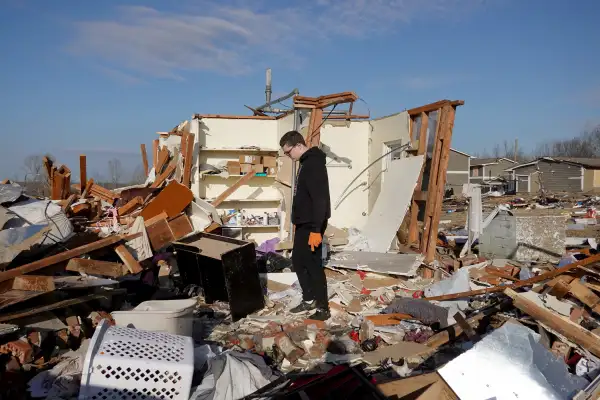'There Are No Safe States': 2021's Terrible Weather Could Hike Home Insurance Costs

It’s official: This has been a record-breaking year for severe weather. Among its legacies, unsurprisingly, could be higher costs to insure your home in 2022.
The weather data for 2021 is truly dire. According to the National Oceanic and Atmospheric Administration, the U.S. endured an unprecedented 18 weather disasters that each caused more than $1 billion in property damage. And the NOAA list isn’t even complete, since it ends on October 8 – meaning it doesn't include the financial tally from December’s devastating tornadoes in Kentucky and other states.
The billion-dollar blowouts occurred in all regions and seasons, and included a drought and wildfires in the west; a hailstorm and thunderstorms in the midwest; spring flooding and Hurricane Ida in the south; and a severe winter storm in the northeast.
While those disasters created a tsunami of home insurance claims, weather isn’t all that’s driving up insurance costs. Pandemic-related shortages in labor and building supplies have boosted the cost to repair and replace homes. And the costs for flood insurance – which requires a separate policy – are on the rise for many homeowners due to new assessments of flooding risk.
Here’s what insurance professionals say you should expect when insuring your home in the coming months, along with a major addition to consider to supplement it – adding a flood policy.
Brace for higher rates and fewer insurers
Whether your costs for home or rental insurance rise in 2021, and by how much, will depend on your carrier and where you live, says Robert M. Lajdziak, director of insurance intelligence at J.D. Power and Associates. “But…yes, we're going to see prices go up for coverage.”
The increases may be substantial, according to Dick Lavey, president of Hanover Agency Markets at The Hanover Insurance Group, who predicts average hikes in “the 8% to 10% range, which is higher than general inflation.” (Those would also be far higher than the change for most homeowners from 2020 to 2021, when the premiums for homeowners and renters insurance actually declined slightly on average, according to the Bureau of Labor Statistics.)
Insurance companies that have sustained huge losses from recent years of mega-wildfires in California, for instance, are sinking resources into sophisticated modeling technology. The adjustments to insurers’ risk modeling programs are not only prompting increases in premiums. Some companies are taking more drastic steps, like dropping out of certain markets entirely.
“Within the last week, I had an insurance company tell me they'd no longer write insurance policies in their admitted states,” says Robb Lanham, chief sales officer for HUB International Personal Insurance. “They can’t make a profit.”
Consider flood insurance
Despite the prospect of pricier premiums, Lajdziak predicts a continuation of growth in people seeking flood insurance policies, driven by the escalation of extreme weather of all types, and the role water plays in much of the property damage.
“The number one cause of loss in the United States for homeowners is water,” Lanham says. “The storms that we have, the hurricanes we have, are more ferocious and bringing more rain.”
The torrential rain that accompanies more storms means that even people who don’t live on the coast could find themselves facing a flood risk: Inland stream and river flooding is a growing concern across a wider swath of the country.
Increasingly, Lanham adds, natural disasters are happening in places where structures aren’t built to withstand those elements. “There are no safe states,” he says, pointing out that “Hurricane Alley” has spread far from coastal Florida and the Southeastern Atlantic shore.
It’s true, as noted, that flood insurance is getting pricier as a whole, as the federal agency that writes most policies has adjusted its rates to more accurately reflect the flood risk a homeowner faces. More than 75% of the roughly 5 million people who have flood insurance will see their premiums rise, but for most the hikes will be modest — $10 a month or less, FEMA says. And many of the remaining homes — many of them more modest dwellings — will actually enjoy a drop in rates, as the new system eliminates what FEMA says were subsidies by those homeowners that helped keep rates low for larger properties in riskier locations.
Your home’s exact location may affect your rates more
The same trend of hyper-localized risk assessment that is changing flood insurance is also coming to home insurance.
Rather than relying on generalized zone maps that assign premiums based on neighborhoods, advances in artificial intelligence and algorithmic analytics let insurers sift through a greater amount of highly granular data such as its surrounding vegetation, which could affect its fire risk. This makes it possible to pinpoint to a much more precise degree which properties are most vulnerable.
Lavey says that most major carriers now use models that incorporate between 40 and 60 different variables to calculate both existing as well as emerging risks. This greater level of precision means that some homeowners will wind up paying more because risk that might have previously gone undetected is now priced into their premium.
But homeowners can make this sophisticated technology work in their favor, Lavey says, since the algorithms in use today let insurers assign both charges for factors that indicate higher risk as well as credits for risk mitigation tools and strategies (such as reinforcing a roof or adding smart monitoring technology).
It’s also worth noting that these new tools won’t be used without regulatory checks and balances. State insurance officials will be tasked with protecting homeowners and making sure that this complex technology is used to benefit consumers.
More from Money:
Best Homeowners Insurance Companies of 2021
If Disaster Strikes, Your Home Insurance May Not Cover the Cost of Rebuilding
Why You Should Consider Flood Insurance Even if You Don’t Live in a Flood Zone
